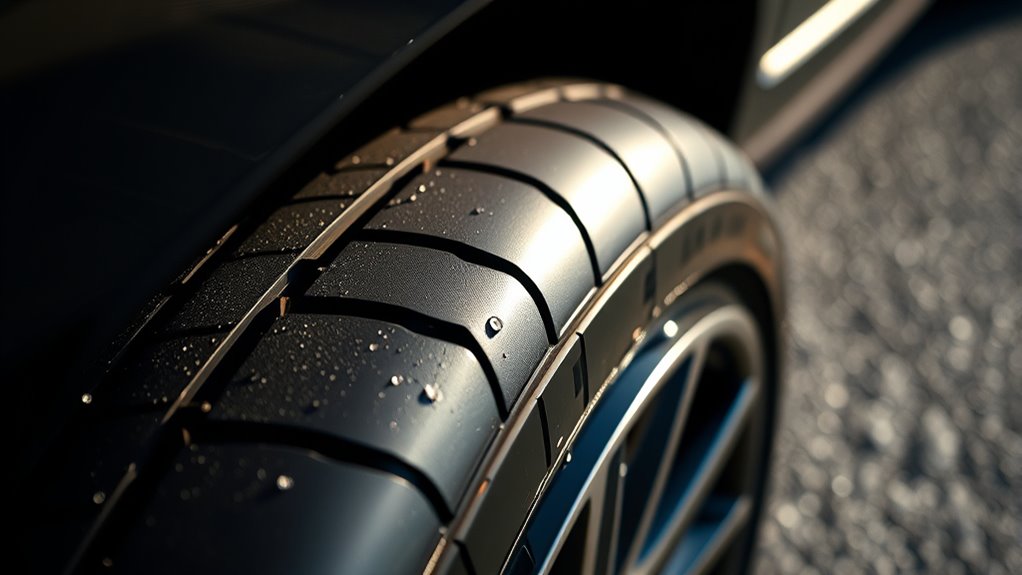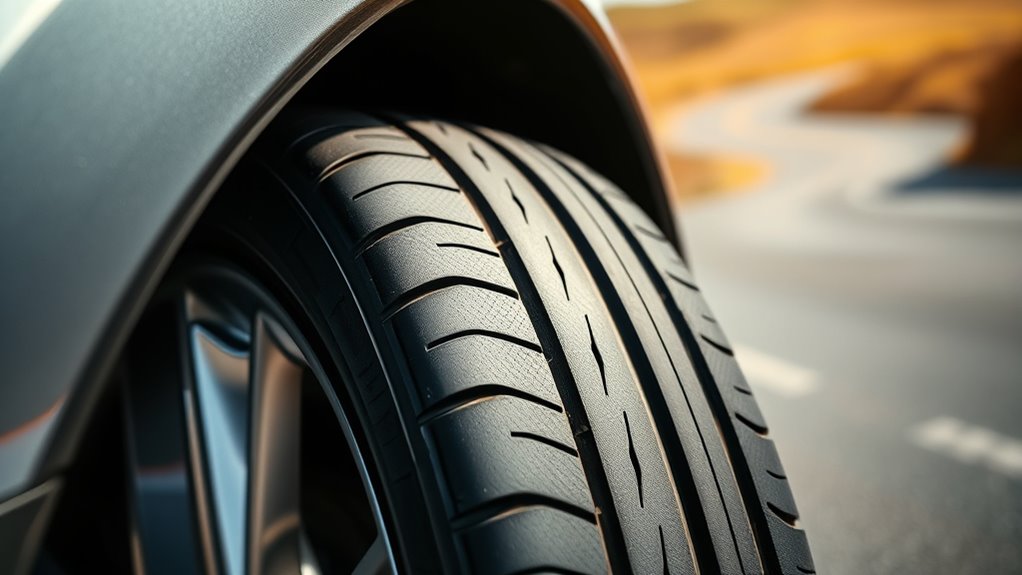Proper tire pressure is more important than you might think because it directly affects your safety, vehicle handling, and fuel efficiency. Underinflated tires wear unevenly and increase the risk of blowouts, while overinflated tires can make your ride bumpy and reduce control. Maintaining the right pressure also lowers emissions and saves you money on fuel. Keep your tires properly inflated, and you’ll improve performance and safety—plus, there’s more you should know to stay safer on the road.
Key Takeaways
- Proper tire pressure ensures vehicle safety by maintaining optimal handling and reducing the risk of blowouts.
- Correct inflation improves fuel efficiency by decreasing rolling resistance and lowering emissions.
- Under- or overinflated tires cause uneven wear, shortening tire lifespan and increasing replacement costs.
- Accurate tire pressure enhances ride comfort by absorbing shocks effectively and preventing rough driving experiences.
- Regular tire pressure checks, aided by advanced monitoring systems, help prevent accidents and improve overall road safety.

Maintaining proper tire pressure is vital for safe and efficient driving. When your tires are properly inflated, you improve not only your vehicle’s performance but also your safety on the road. Many drivers overlook the importance of tire maintenance, assuming that as long as their tires seem okay, they’re fine. However, underinflated or overinflated tires can lead to serious safety concerns, increasing the risk of accidents and reducing your vehicle’s lifespan. Regularly checking and maintaining your tire pressure is a simple yet essential step to guarantee your driving experience remains safe and smooth.
Proper tire pressure ensures safety, performance, and longevity—regular checks are essential for a smooth, secure drive.
Incorrect tire pressure affects how your vehicle handles, especially during emergency maneuvers or sudden stops. Underinflated tires tend to have a larger contact patch with the road, which might sound good for grip but actually causes uneven wear and reduces overall control. Overinflated tires, on the other hand, become less able to absorb shocks from potholes or rough surfaces, making your ride bumpier and increasing the likelihood of tire damage. Both scenarios compromise safety, as they impair your ability to respond quickly to road hazards. This is why tire maintenance isn’t just about saving money on fuel or prolonging tire life; it’s about safeguarding yourself and others from avoidable accidents.
Proper tire pressure also plays a vital role in fuel efficiency. When your tires are correctly inflated, your vehicle doesn’t have to work as hard to move, which means better gas mileage. Conversely, underinflated tires cause increased rolling resistance, leading to higher fuel consumption and more emissions. Over time, neglecting tire maintenance can cost you more at the pump and harm the environment. Yet, many drivers forget to regularly check their tire pressure, relying solely on visual cues or ignoring the issue altogether. Setting a routine to check your tire pressure at least once a month guarantees you catch any issues early and maintain ideal safety standards.
Another safety concern linked to improper tire pressure is tire blowouts, which can happen unexpectedly if your tires are considerably under or overinflated. These blowouts can cause you to lose control of your vehicle, especially at high speeds. Properly inflated tires distribute stress evenly across the sidewalls and tread, reducing the chance of sudden failure. Keeping an eye on tire pressure is a simple step that offers peace of mind, preventing potentially dangerous situations on the road. Remember, your safety depends on proactive tire maintenance—don’t wait until you notice a problem, check your tire pressure regularly for a safer driving experience. Additionally, advancements in robotics in vehicle maintenance are making tire monitoring more automated and precise.
Frequently Asked Questions
How Often Should I Check My Tire Pressure?
You should check your tire pressure at least once a month to prevent uneven tire wear and guarantee safe driving. Use reliable inflation tools to get accurate readings. Regular checks help you catch deflation early, extending tire life and improving fuel efficiency. Don’t forget to check before long trips or when the temperature drops, as cold weather can reduce pressure. Keeping an eye on your tires keeps you safer on the road.
Can Incorrect Tire Pressure Affect Fuel Economy?
If your tire pressure isn’t spot-on, it can totally ruin your fuel economy—like driving with a flat tire, but sneaky! Incorrect tire pressure affects tire pressure stability, making your engine work harder. Staying at ideal inflation levels ensures your tires roll smoothly, saving you money and reducing emissions. Don’t overlook this tiny detail; it’s the secret to better mileage and safer driving. Check your tire pressure regularly!
What Signs Indicate My Tires Need Air?
You’ll notice your tires need air if you see uneven tire wear or if your car feels less responsive while handling. Under-inflated tires often cause poor handling stability, making steering feel sluggish, and can lead to faster tire wear. Regularly check your tire pressure and look for visual signs like bulges or low tread. Maintaining proper pressure guarantees better handling and extends tire life.
Does Tire Pressure Vary With Temperature?
Think of your tires like a balloon that expands and contracts with temperature fluctuations. As temperatures drop, tire pressure decreases; when it warms up, pressure rises. This means you need regular tire pressure adjustment to maintain peak performance and safety. If you ignore these changes, your tires could be underinflated or overinflated, affecting your fuel efficiency and tire lifespan. Always check and adjust your tire pressure according to seasonal temperature shifts.
Is It Safe to Drive With Underinflated Tires?
Driving with underinflated tires isn’t safe, despite common tire pressure myths suggesting otherwise. It increases your risk of blowouts, reduces fuel efficiency, and causes uneven tire wear. Always use reliable air pressure tools to check your tire pressure regularly, especially in different temperatures. Properly inflated tires ensure safety, peak handling, and longer tire life. Don’t ignore the signs—maintain correct tire pressure for a safer, smoother ride.
Conclusion
Think of your tires as the heartbeat of your car—when they’re properly inflated, everything runs smoothly like a well-orchestrated symphony. Keep an eye on the pressure, and you’ll steer through your journeys with confidence and ease. Ignoring it is like trying to sail a boat with a leaky hull—eventually, problems arise. So, check your tire pressure regularly and keep your ride steady, safe, and ready to roll wherever life takes you.









